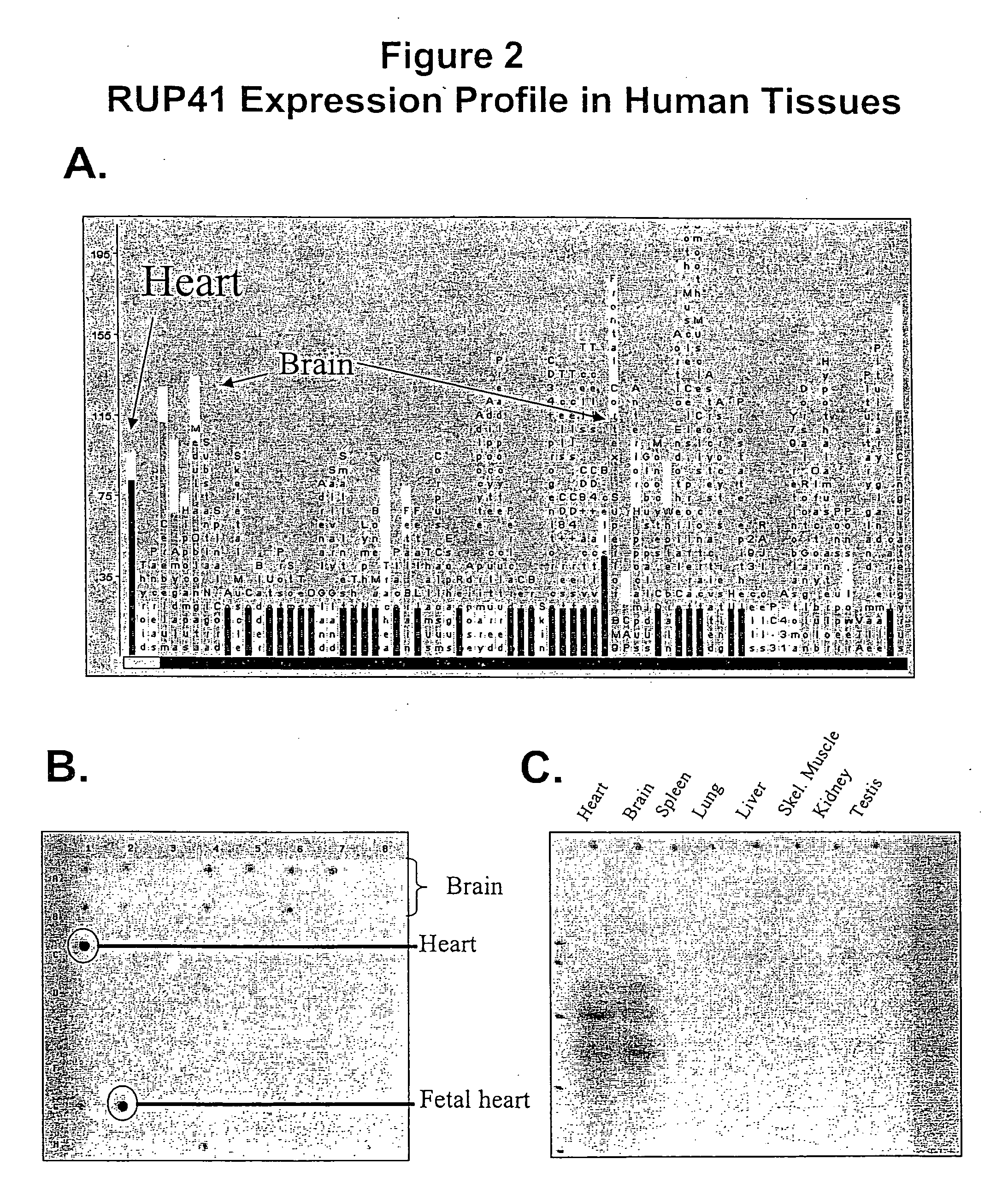Human G protein-coupled receptor and modulators thereof for the treatment of ischemic heart disease and congestive heart failure
a human g protein and receptor technology, applied in the field of human g protein-coupled receptors and modulators thereof for the treatment of ischemic heart disease and congestive heart failure, can solve the problems of not being able to directly activate survival pathways or inhibit cardiac myocyte death drugs currently available in the clinic, and achieve the effect of reducing cardiac output and increasing venous pressur
- Summary
- Abstract
- Description
- Claims
- Application Information
AI Technical Summary
Benefits of technology
Problems solved by technology
Method used
Image
Examples
example 1
Full-Length Cloning of Endogenous Human RUP41
[0584] The disclosed human RUP41 was identified based upon the use of the GenBank database information. While searching the database, a cDNA clone with Accession Number U66581 was identified as a human genomic sequence from chromosome 7. The fall length RUP41 was cloned by PCR using primers:
5′-TCCCCCGGGAAAAAAACCAACTGCTGCAAA-3′(SEQ ID NO:7; sense),5′-TAGGATCCATTTGAATGTGGATTTGGTGAAA-3′(SEQ ID NO:8; antisense, containing a BamHI site)
and human genomic DNA as template. Amplification was carried out using rTth polymerase (Perkin Elmer) with the buffer system provided by the manufacturer, 0.25 mM of each primer, and 0.2 mM of each 4 nucleotides. The cycle condition was 30 cycles of 94° C. for 1 min, 50° C. for 1 min and 72° C. for 1.5 min. The 5′ PCR primer was kinased and the 1.38 kb PCR fragment was digested with BamHI and cloned into EcoRV-BamHI site of pCMV expression vector. See, SEQ ID NO:1 for nucleic acid sequence and SEQ ID NO:2 fo...
example 2
Preparation of Non-Endogenous, Constitutively Activated Human RUP41
[0585] Those skilled in the art are credited with the ability to select techniques for mutation of a nucleic acid sequence. Presented below are approaches utilized to create non-endogenous versions of human GPCRs. The mutation disclosed below for RUP41 is based upon an algorithmic approach whereby the 16th amino acid (located in the IC3 region of the GPCR) from a conserved proline (or an endogenous, conservative substitution therefor) residue (located in the TM6 region of the GPCR, near the TM6 / IC3 interface) is mutated, preferably to an alanine, histidine, arginine or lysine amino acid residue, most preferably to a lysine amino acid residue.
[0586] Non-endogenous, constitutively activated full-length human RUP41 is accomplished by mutation of the phenylalanine residue at amino acid position 312 of SEQ ID NO:2 or SEQ ID NO:3 to lysine (F312K).
[0587] 1. Transformer Site-Directed™ Mutagenesis
[0588] Preparation of n...
example 3
Receptor Expression
[0591] Although a variety of cells are available to the art for the expression of proteins, it is most preferred that mammalian cells or melanophores be utilized. The primary reason for this is predicated upon practicalities, i.e., utilization of, e.g., yeast cells for the expression of a GPCR, while possible, introduces into the protocol a non-mammalian cell which may not (indeed, in the case of yeast, does not) include the receptor-coupling, genetic-mechanism and secretary pathways that have evolved for mammalian systems—thus, results obtained in non-mammalian cells, while of potential use, are not as preferred as that obtained from mammalian cells or melanophores. Of the mammalian cells, CHO, COS-7, 293 and 293T cells are particularly preferred, although the specific mammalian cell utilized can be predicated upon the particular needs of the artisan. See infra as relates to melanophores, including Example 8.
[0592] a. Transient Transfection
[0593] On day one, ...
PUM
| Property | Measurement | Unit |
|---|---|---|
| dissociation constant | aaaaa | aaaaa |
| dissociation constant | aaaaa | aaaaa |
| dissociation constant | aaaaa | aaaaa |
Abstract
Description
Claims
Application Information
 Login to View More
Login to View More - R&D
- Intellectual Property
- Life Sciences
- Materials
- Tech Scout
- Unparalleled Data Quality
- Higher Quality Content
- 60% Fewer Hallucinations
Browse by: Latest US Patents, China's latest patents, Technical Efficacy Thesaurus, Application Domain, Technology Topic, Popular Technical Reports.
© 2025 PatSnap. All rights reserved.Legal|Privacy policy|Modern Slavery Act Transparency Statement|Sitemap|About US| Contact US: help@patsnap.com



